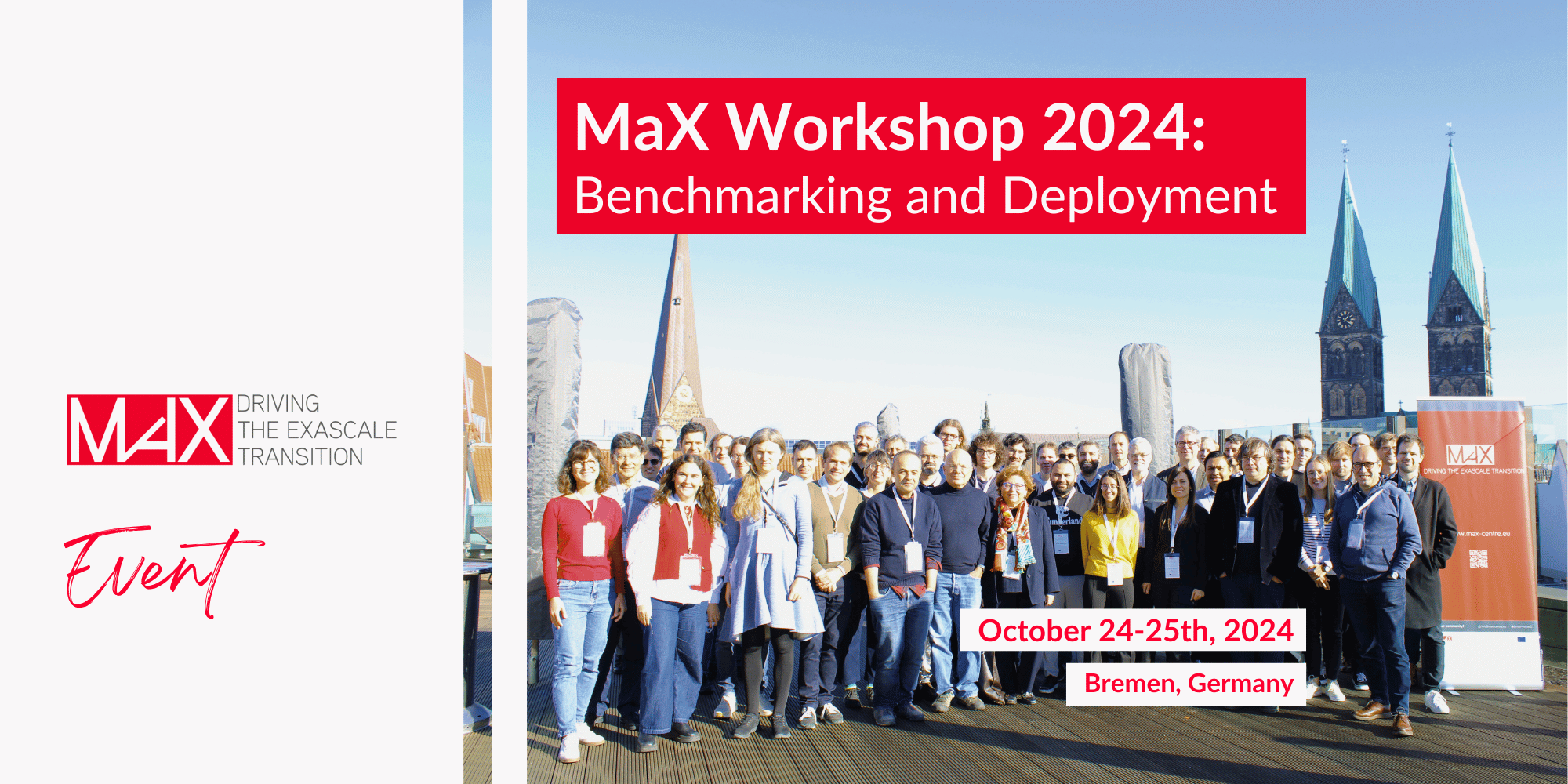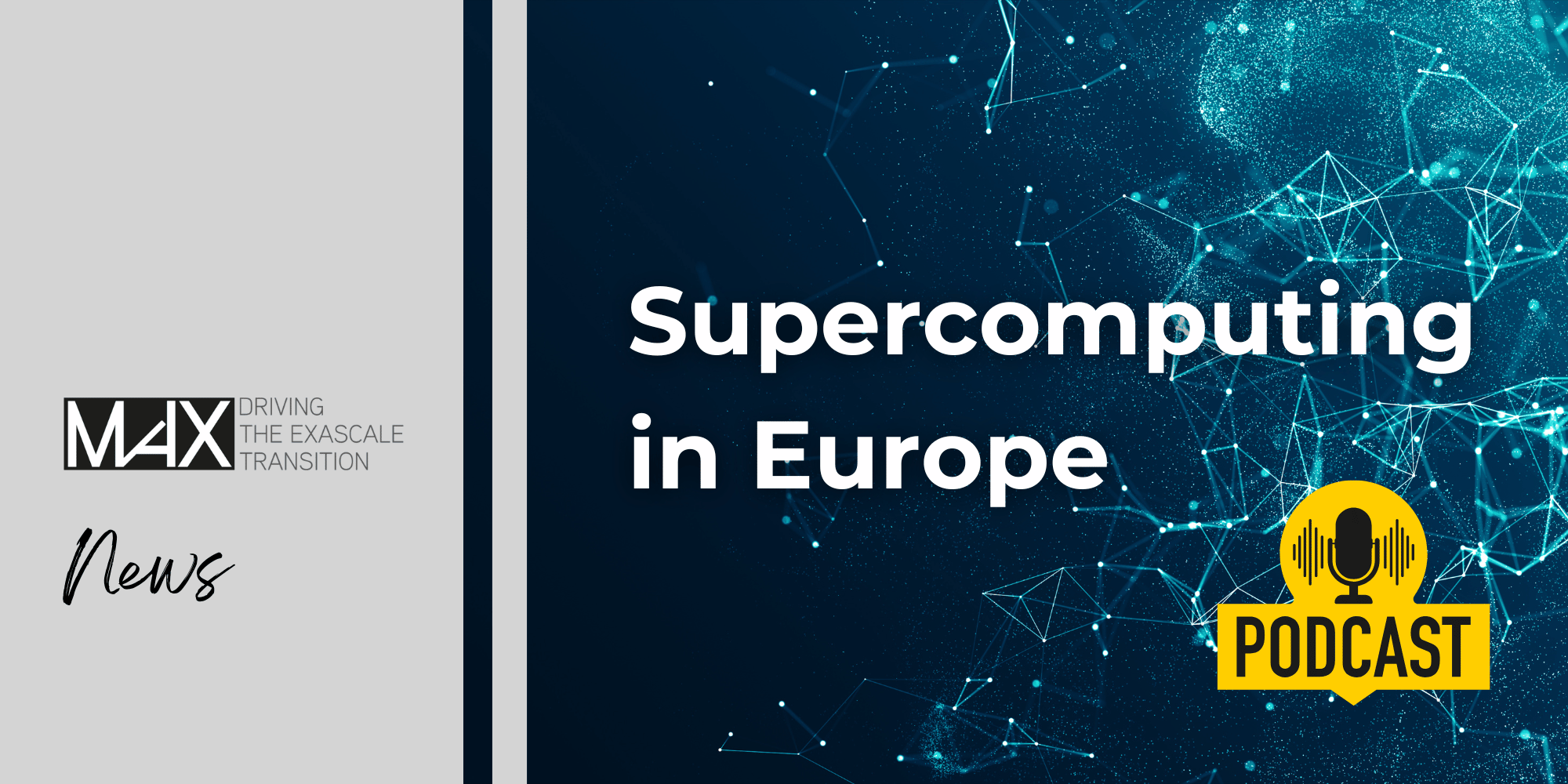MaX partners gathered in Bremen for their 3rd project meeting
Surrounded by the cultural heritage of Bremen, MaX partners engaged in two intensive days of discussions on deployment, benchmarking, and profiling.

On October 24–25, 2024, MaX partners convened in Bremen, Germany, for an open workshop that attracted students, postdocs, researchers, and scientists interested in MaX initiatives and results. Surrounded by the cultural heritage of Bremen, participants engaged in two intensive days of discussions and exchanges.
The workshop provided an opportunity to review this last year's activities and achievements across key areas: deployment and benchmarking of MaX codes on EuroHPC architectures, energy efficiency evaluation on selected HPC platforms, exascale workflows, AI integration, training initiatives and outreach efforts. Partners delivered in-depth presentations detailing the progress and tasks realised, the key results achieved, the challenges faced, and the next steps ahead.
Below we provide an overview of the most significant highlights of the meeting. This summary captures the key discussions, achievements, and insights shared by the project partners.
Enjoy the reading.

Highlights from MaX Workshop in Bremen
Evaluating the first two years of MaX: insights and strategic directions for the future of the project
«Throughout the project lifetime, we will continue to focus heavily on advancing and optimising our lighthouse codes, particularly regarding time-to-solution and energy efficiency. This means being ready to deploy and run exascale workflows on the available EuroHPC machines to tackle some of the biggest questions in materials science. AI will play a pivotal role here. We’re working to integrate AI-driven methods directly into our exascale workflows and codes, to make them even more powerful and efficient.» Andrea Ferretti (CNR-Nano)
In its first two years of activity, MaX has worked to advance its open-source community codes for quantum material simulations and prepare them for the exascale transition. The effort has been focused on porting, scaling, and optimising these codes across new, diverse architectures, while integrating them into "exascale workflows". MaX has also addressed energy efficiency evaluation and performance analysis, leveraging the latest hardware capabilities while tackling challenges related to a fast-evolving HPC and data scenario. Looking ahead, the main goals for MaX over the next two years are to further develop and optimise its lighthouse codes in terms of time- and energy-to-solution, with immediate emphasis on EU exascale systems like JUPITER and JULES-VERNE. This will involve scaling workflows for exascale applications in materials science, while increasingly integrating AI capabilities to enhance computational efficiency. MaX will ensure that its codes are readily deployable on EuroHPC systems and that users can access the latest versions with robust hands-on training. Through collaboration with hardware providers and integrators, including SiPearl, EVIDEN, and E4, MaX codes and mini-apps will be used as codesign vehicles with a strong focus on EU-relevant hardware. This involves testing on the Rhea chips and the EUPEX prototype, as well as emerging technologies such as RISC-V.
Executive summary and future perspectives on the MaX project were presented by MaX Coordinator Elisa Molinari (Full Professor of Condensed Matter Physics, UNIMORE, and Research associate, CNR-Nano) and Andrea Ferretti (Senior Researcher, CNR-Nano).
__________
Adapting MaX codes to heterogeneous architectures for materials design and simulation
«Materials play an essential role across a wide spectrum, from life sciences to astrophysics, and are integral to a diverse range of technologies, including pharmaceuticals, microelectronics, and information sciences. Max codes not only facilitate the prediction of material behaviours, but also provide a powerful tool for the design of novel materials and molecules with tailored properties to meet specific, application-driven requirements.» Stefano Baroni (SISSA)
The MaX codes, developed over several decades, were originally designed for simpler computer architectures, where portability across different systems was straightforward. With the introduction of hybrid architectures, the underlying coding paradigms have evolved, making the migration of these legacy codes to the new platforms increasingly complex. The advent of new architectures, particularly those leveraging GPU cards and other floating-point accelerators, implies the migration of legacy codes to these advanced systems. This transition demands significant effort, to witch all of the work and resources of the Centres of Excellence are currently being devoted.
Progress on the MaX lighthouse codes were presented by Stefano Baroni (Professor of Theoretical Condensed-Matter Physics, SISSA), followed by detailed presentations given by the representatives of the MaX codes’ developers teams.
__________
Deployment of MaX codes across EuroHPC architectures
«The deployment of the five MaX lighthouse codes on the EuroHPC machines is critically important for MaX as it ensures the availability and functionality of our codes on a number of HPC systems. This also supports the EuroHPC JU vision of making codes and HPC systems more accessible. In fact, deployment facilitates the broader use of scientific applications across different computing environments, and this is essential for the entire European scientific community. For researchers, having codes available on any EuroHPC machines provides greater flexibility when requesting computing resources.» Nicola Spallanzani (CNR-Nano)
In the initial phase of the MaX project, one of the primary focuses has been to create streamlined installation workflows to facilitate the deployment of MaX codes across a range of heterogeneous EuroHPC architectures. Close collaboration with computing centres has been instrumental in enabling the deployment of MaX applications on multiple EuroHPC systems. By the end of the project, the goal is to ensure that all MaX codes are fully ported and operational across the entire suite of EuroHPC systems, covering both accelerated and non-accelerated partitions.
MaX strategy for scalability and compatibility in the expanding EuroHPC ecosystem
«Code quality and deployment are two targets that MaX is really paying lots of attention to, because we think that the development and our user communities both require feedback and more and more improvement. With the new infrastructure and the new ecosystems, we are also now paying more attention to profiling the new architectures. The development requires more and more support to take advantage of the accelerators, to manage the memory architecture, and the input and output, to really make sure that we can use those machines to the biggest benefit, not just for efficiency and time to result, but also to really exploit the machines to their entire capacity.» Jan Jona Javorsek (Jožef Stefan Institute)
MaX supports advanced codes in materials science under active development, with a substantial user base relying on their stability and scalability. To sustain this, MaX is establishing standardised processes that allow for adaptive usage of the evolving EuroHPC ecosystem. As EuroHPC continues to introduce new architectures and deploy next-generation boosters, automation is the only viable path forward to maintain compatibility and scalability. In this context, MaX goal is not only to support developers within the MaX community but also to future-proof the deployments of the MaX codes across EuroHPC evolving infrastructure. MaX aims to ensure that, as new systems become available, MaX codes are accessible, fully documented, and optimised for immediate use, reinforcing FAIR data principles and supporting open science practices. This ongoing improvement requires continuous adaptation to new machines and centres and brings in new partners and valuable collaborators. As MaX continues to advance in its third phase, these efforts are expected to yield impactful results for the entire EuroHPC ecosystem.
Achievements on the deployment of MaX lighthouse codes on the EuroHPC machines were presented by Nicola Spallanzani (HPC Technologist, CNR-Nano) and Jan Jona Javorsek (Head of Networking Infrastructure Centre, Jožef Stefan Institute).
__________
Benchmarking for MaX codes: optimising performance across EuroHPC architectures for the exascale transition
«Benchmarking of MaX codes on many different heterogeneous architectures is crucial to monitor the code performance and efficiency. This procedure allows us to identify possible bottlenecks related to the code or to the architectures. Until now, MaX has been working mainly on the benchmark set up. Throughout the project, we will continue to work on the benchmarking and the optimisation of MaX codes to take full advantage of all the available architectures and to prepare MaX codes for the exascale era.» Mariella Ippolito (HPC Specialist, CINECA)
Benchmarking of MaX lighthouse codes is essential to effectively assess and optimise code performance across diverse heterogeneous architectures. Benchmarking not only facilitates real-time monitoring of code performance but also enables the identification of bottlenecks—whether arising from the code itself or from specific architectural features. In this context, MaX initial efforts have centred on establishing a robust benchmarking framework, selecting JUBE as the official MaX benchmarking tool. With this choice, MaX can systematically configure and execute code benchmarks across all EuroHPC architectures, ensuring a standardised approach to performance evaluation. MaX has begun gathering benchmark data from various architectures. The results are routinely updated in the official MaX Benchmark repository. Additionally, an interactive visualisation tool was developed to dynamically present benchmarking results on a web interface, enabling easy access and analysis. Looking forward, MaX will continue refining and optimising its codes across EuroHPC platforms to maximise the potential of the newly available EuroHPC machines.
Achievements on benchmarking and profiling of MaX lighthouse codes on the EuroHPC machines were presented by Mariella Ippolito (HPC Specialist, CINECA) and Fabio Affinito (HPC Application Support, CINECA).
__________

Enhancing energy-efficiency of MaX codes on HPC hardware platforms
«Large HPC machines mean high power consumption. In the case of exascale or pre-exascale systems, we are speaking of several megawatts. MaX codes are scaled to a significant part of such machines, thus the responsibility for the efficient usage of assigned resources is in the hands of the co-developers and the consortium partners. Looking forward, our goal is to use energy-efficient runtime systems to execute the MaX codes. These systems dynamically change the hardware configurations to fit the executed workload and push the energy savings to the maximum possible.» Ondřej Vysocký (IT4Innovations)
MaX has ported its codes to a range of advanced HPC platforms, incorporating co-design strategies to enhance energy efficiency. This includes:
(i) assessing energy consumption across platforms;
(ii) exploring hardware configuration adjustments to reduce power usage without compromising application performance;
(iii) extending the benchmarking framework to include energy measurement capabilities.
Looking forward, MaX is going to use energy-efficient runtime systems to execute its codes. These systems dynamically adjust hardware configurations based on workload demands, maximising potential energy savings while maintaining performance.
Achievements on energy efficiency evaluation of MaX codes on selected HPC hardware platforms were presented by Ondřej Vysocký (Senior Researcher, IT4Innovations).
__________
Advancing AI-driven materials science: the role of MaX in automated simulations and curated data
«Artificial intelligence is clearly a game-changer in the world of materials. In MaX we are developing automated "externalizable" simulation capabilities that are really the building blocks to let not only human actors, but also autonomous agents, driven by AI, drive the capabilities that are needed. Right now, we have humans that run the simulations that are needed. In the near future, we'll have AI that decides what needs to be run.» Nicola Marzari (Universität Bremen)
MaX effort in integrating AI into materials science research involves two distinct but complementary aspects. The first aspect concerns the generation and use of "curated" materials datasets—an area where the MaX and EuroHPC ecosystem are particularly equipped. This high-quality dataset will be used as a foundation for training machine learning models and significantly enhance the analytical reach and predictive accuracy of simulation codes. The second, more forward-looking aspect concerns the development of automated, "externalizable" simulation capabilities. These are universal simulation functions designed to be operated through standardised service interfaces, enabling broader accessibility and integration across various platforms and applications.
Building a foundation for AI in materials science: MaX role in generating reliable data
«As a consortium dealing with or developing electronic structure codes based on density functional theory, we see it as our responsibility to create methods that produce high-quality, reliable data for the entire scientific community. This foundation is essential to ensure that AI techniques applied in the fields of materials and computer sciences can deliver consistent and reproducible results.» Stefan Blügel (Forschungszentrum Jülich)
Significant advancements in science and society are increasingly driven by the application of AI methodologies, which are most effective when substantial datasets are used. As a consortium, MaX is committed to create high-quality, reliable data. In this third phase of the project, MaX efforts aim to ensure that AI-driven analyses within the community are grounded in reliable, reproducible data, supporting robust and accurate outcomes in research and applications.
Discussions on the use of AI in materials science research were presented by Nicola Marzari (UBremen Excellence Chair, Universität Bremen) and Stefan Blügel (Director of Institute Quantum Theory of Materials at Forschungszentrum Jülich).
__________
MaX digital infrastructure for scalable access to HPC
«What we are building in MaX is a digital infrastructure that parallels traditional scientific facilities—such as synchrotrons and radio telescopes—but with the advantages of being inherently sharable, easily redeployable, and accessible to a wider scientific community. Unlike physical infrastructures limited by capacity, this digital infrastructure provides scalable, flexible access to the powerful EuroHPC resources.» Nicola Marzari (Universität Bremen)
MaX is developing a digital infrastructure that is inherently shareable, redeployable, and accessible to the broad scientific community. Unlike physical infrastructures, that are limited by capacity, the digital framework developed by MaX offers scalable and flexible access to the powerful HPC resources provided by the EuroHPC JU. This strategy allows MaX to function as a front-end gateway, facilitating access to HPC resources for a diverse range of users, including computational scientists, materials researchers, and experimentalists. Through MaX codes and digital infrastructure, users are able to perform reliable, automated simulations designed for specific materials properties without requiring extensive knowledge of the complex HPC backend or the intricacies of the code. This framework thus expands access to advanced simulation capabilities, promoting innovative materials research and discoveries.
Achievements on exascale workflows design, orchestration, and implementation were presented by Nicola Marzari (UBremen Excellence Chair, Universität Bremen) and Alberto Garcia (Research Scientist, ICMAB).
__________
Training initiatives to promote MaX lighthouse code use in the HPC ecosystem
«Training is a core element for MaX as it aims to optimise its lighthouse codes across various architectures, particularly in preparation for the upcoming EuroHPC exascale systems. The transition to these advanced platforms requires that both developers and end-users adapt to a new paradigm in HPC. As a consequence, MaX's training initiatives focus on cultivating a new generation of developers while raising user awareness to maximise the use of cutting-edge HPC capabilities.» Daniele Varsano (CNR-Nano)
Over the past two years, MaX has provided domain-specific training in materials science through hands-on schools, hackathons, and workshops. These training programmes offer participants a solid theoretical foundation in the methodologies employed in MaX codes, supplemented by practical experience on best practices for using the codes on HPC systems. In the third phase of the project, training events have been conducted both online and in-person, with hackathons facilitating collaboration between emerging and more experienced developers. All MaX training material is made accessible via video recordings on a dedicated platform, ensuring availability to a wide audience. Looking forward, MaX plans to continue organising events in line with its training roadmap, with the calendar for 2025 already fully scheduled and available on the MaX website. MaX focus remains on delivering high-quality trainings, often in collaboration with HPC supercomputing centres, national HPC competence centres, and community organisations within the field of materials and computer science. The strong demand reflected in the high volume of applications received in the past two years motivates MaX to expand its training offer and accommodate as many participants as possible.
Updates on training and community engagement activities within the HPC ecosystem were presented by Daniele Varsano (Senior Researcher, CNR-Nano).
__________
Enhancing stakeholder engagement: MaX strategy for impactful communications and collaborations
«An impactful communication, exploitation, and dissemination strategy is essential for MaX, to ensure that the project’s objectives, achievements, and milestones effectively reach our diverse target audiences. MaX efforts are focused on enhancing our brand, disseminate our results, and fostering collaborations with other Centers of Excellence (CoE) and National Competence Centers (NCC), under the CASTIEL2 framework, to collectively promote the upcoming exascale transition in Europe.» Marina Corradini (ICN2)
As we prepare for the exascale transition in Europe, an effective strategy for communication, exploitation, and dissemination of the MaX project is critical to making HPC and its use in materials science research accessible and understood. Over the past two years, MaX has broadened its global outreach through a variety of channels, including conferences, scientific publications, training initiatives, social media campaigns, newsletters, and technical brochures. This approach has successfully highlighted the project’s results to a broad audience, including both the general public and experts in materials and computational sciences. Looking ahead, MaX has planned several initiatives to further showcase its achievements. Collaborations within the EuroHPC ecosystem and the CASTIEL2 framework remain essential for this effort, with each partner, CoE, and NCC playing a critical role in the overall success of the EuroHPC mission.
Achievements on the MaX communication, exploitation, and dissemination activities were presented by Marina Corradini (Communication Project Officer, ICN2).
__________
We extend our gratitude to all attendees who joined us in Bremen. We thank each of our partners for their dedicated efforts over the first two years of the project and for their outstanding contributions. Special thanks go to the project coordinator and the management team involved in organising the meeting. We are also grateful to our Bremen partners for hosting our third project gathering.




